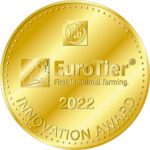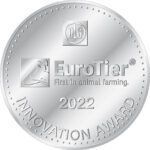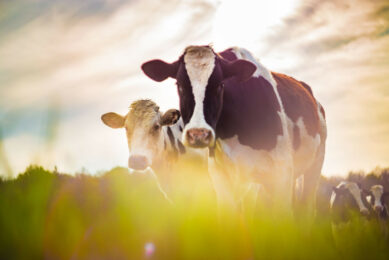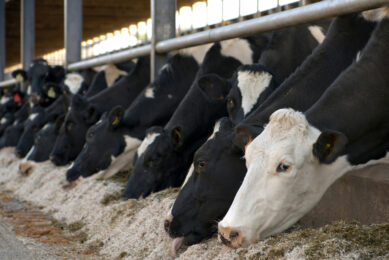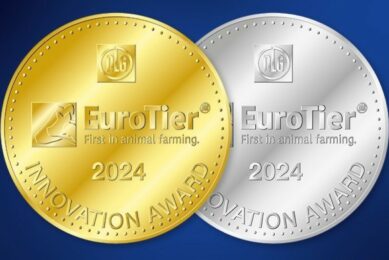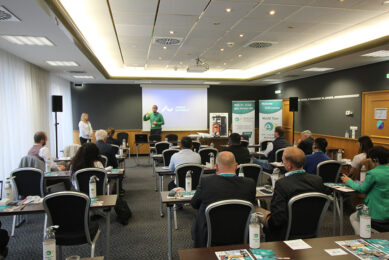Don’t miss it! EuroTier 2022 award winners and innovations
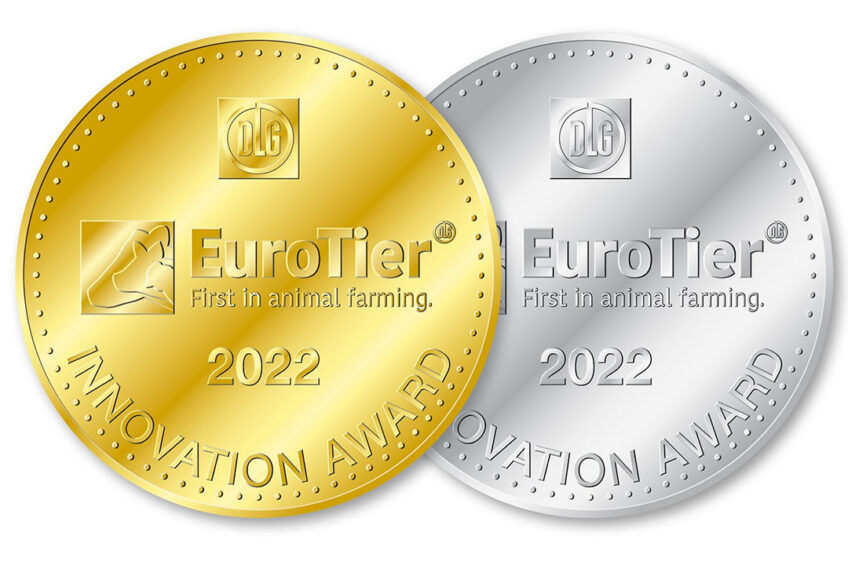
In the build up to the big event the organiser DLG has presented four gold medals and 14 silver medals for new products that have impressed independent judges. The dairy sector scooped 2 gold and 6 silver medals.
Naturally drying cows off
GEA AutoDry (Hall 13, stand C26)
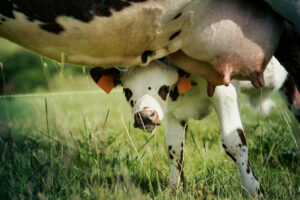 The AutoDry management software system was initially developed for conventional milking systems. Current developments are ongoing to make it ready for robotic milking. It can be activated for individual cows and prepares them gently and effectively for drying off. AutoDry introduces automatic milking cluster removal after reaching a pre-defined target milk volume. AutoDry starts around 10 days before drying off and gradually reduces milk production each additional day using a patented algorithm.
The AutoDry management software system was initially developed for conventional milking systems. Current developments are ongoing to make it ready for robotic milking. It can be activated for individual cows and prepares them gently and effectively for drying off. AutoDry introduces automatic milking cluster removal after reaching a pre-defined target milk volume. AutoDry starts around 10 days before drying off and gradually reduces milk production each additional day using a patented algorithm.Less stress with milking
Siliconform Stimulor StressLess
(Hall 13, stand C51)
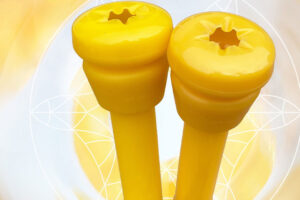 The Stimulor StressLess from Siliconform enables teats of different sizes to be milked using the same teat cup liner.
The Stimulor StressLess from Siliconform enables teats of different sizes to be milked using the same teat cup liner.
The new, wave-shaped design of the lip responds to the difference in pressure in the teat cup liner and allows outside air to flow in to equalise it if necessary. This prevents an excessively high head vacuum, delays teat cup ascent and reduces tissue stress.
In the same way, the wave-shaped structure regulates or closes again at the right point in time and keeps the head vacuum stable at an ideal level in order to hold the cup on the udder, preventing undesired air ingress or the cups from falling off.
Optimise supply of vitamin E in calves
Vilofoss CareFoss E-Force
(Hall 21, stand J08)
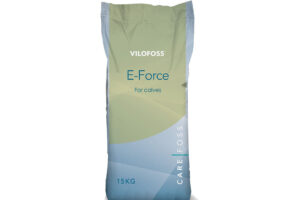 The Carefoss E-Force is a supplementary feed formulated to optimise the supply of vitamin E in calves. RRR-tocopherol sheathed with lecithin to offer good oxidation protection is used as a source of vitamin E rather than the usual tocopherol acetate, because it is more readily absorbed. CareFoss E-Force can significantly increase the plasma vitamin E level of calves during and after weaning. The lower plasma amyloid and cortisol values also indicate a reduced stress and inflammation level.
The Carefoss E-Force is a supplementary feed formulated to optimise the supply of vitamin E in calves. RRR-tocopherol sheathed with lecithin to offer good oxidation protection is used as a source of vitamin E rather than the usual tocopherol acetate, because it is more readily absorbed. CareFoss E-Force can significantly increase the plasma vitamin E level of calves during and after weaning. The lower plasma amyloid and cortisol values also indicate a reduced stress and inflammation level.
Feed additive to reduce methane
DSM Nutritional Products – Bovaer
(Hall 22 stand A25)
 Bovaer is a preparation consisting of 3-nitrooxypropanol (3NOP), which has been approved as a feed additive in feeds for dairy cows and cows which helps reduce methane. The effect of the newly developed molecule 3NOP in reducing methane formation in the rumen was confirmed during the approval process. 3NOP inactivates the methyl-coenzyme M reductase, which catalyses the final step of methanogenesis. In the rumen, the molecule itself is metabolised to form 1,3-propandiol, nitrate and nitrite, and has no disadvantageous effects on the health of the animals, consumer safety or the environment.
Bovaer is a preparation consisting of 3-nitrooxypropanol (3NOP), which has been approved as a feed additive in feeds for dairy cows and cows which helps reduce methane. The effect of the newly developed molecule 3NOP in reducing methane formation in the rumen was confirmed during the approval process. 3NOP inactivates the methyl-coenzyme M reductase, which catalyses the final step of methanogenesis. In the rumen, the molecule itself is metabolised to form 1,3-propandiol, nitrate and nitrite, and has no disadvantageous effects on the health of the animals, consumer safety or the environment.
Bedding cleaner
Hanskamp AgroTech BeddingCleaner
(Hall 13, stand D53)
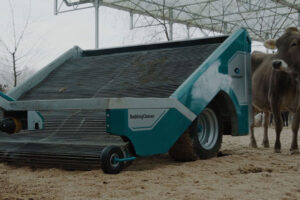 Pulled by a tractor, the BeddingCleaner cleans the bedding from cow barns when required. Bedding material is sieved using a sieve mat. The bedding that is not contaminated drops back into the stable. Conversely, a small amount of the bedding material sticks to the settled faeces so that it can be easily collected by the mounting and transported into the integrated storage bunker. Bedding material subsequently remains cleaner and drier and can be used for longer periods.
Pulled by a tractor, the BeddingCleaner cleans the bedding from cow barns when required. Bedding material is sieved using a sieve mat. The bedding that is not contaminated drops back into the stable. Conversely, a small amount of the bedding material sticks to the settled faeces so that it can be easily collected by the mounting and transported into the integrated storage bunker. Bedding material subsequently remains cleaner and drier and can be used for longer periods.
Making cleaning out milk feeders easy
Forster Technik Clean and Fill Station
(Hall 13, stand D35)
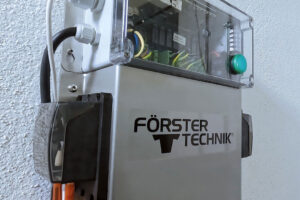 Clean & Fill Station from Forster Technik makes cleaning out large milk feeders easier. It enables the mobile milk tank to be connected using just a few manual steps in order to clean it. The cleaning program runs fully automatically and cleans all surfaces as well as the sensitive areas.
Clean & Fill Station from Forster Technik makes cleaning out large milk feeders easier. It enables the mobile milk tank to be connected using just a few manual steps in order to clean it. The cleaning program runs fully automatically and cleans all surfaces as well as the sensitive areas.
The tank is automatically refilled with water at the required point in time via the set program and is heated to the specified drinker temperature. This means that the farmer then only has to add the required quantity of milk substitute and the calf drinker is ready for use.
Cow housing comfort
Cowhouse International Dreamstall
(Hall 12, stand C57)
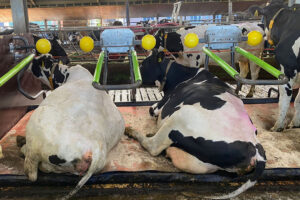 The Dreamstall cubicle bar enables the cows to stand virtually freely in the cubicles and to move more naturally. The special feature of this is that this cubicle design forgoes the classic neck tube and the conventional, classic dividing bars. The neck tube is replaced by the two flexible, spherical bodies that guide the standing cow’s shoulder area. This enables the cow to stand freely in a ‘gap’ and with her head raised even in the cubicle. The conventional dividing bars are replaced by two horizontal, flexible guide frames that guide the standing cow to a central standing position.
The Dreamstall cubicle bar enables the cows to stand virtually freely in the cubicles and to move more naturally. The special feature of this is that this cubicle design forgoes the classic neck tube and the conventional, classic dividing bars. The neck tube is replaced by the two flexible, spherical bodies that guide the standing cow’s shoulder area. This enables the cow to stand freely in a ‘gap’ and with her head raised even in the cubicle. The conventional dividing bars are replaced by two horizontal, flexible guide frames that guide the standing cow to a central standing position.
Cleaning unit
Lakto Hayvancilik Laktowash
(Hall 13 stand E61)
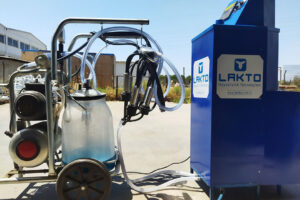 Laktowash is a cleaning unit for mobile bucket milking systems that thoroughly cleans all surfaces which the milk comes into contact with. The mobile milking unit is connected to Laktowash using a simple adapter over the bucket lid. The vacuum pump fitted in the milking unit ensures the required turbulence while Laktowash runs through a pre-specified cleaning and disinfection cycle with corresponding standards, thus ensuring that the milking cluster and milk can are cleaned to a high level. At the end of each washing process, Laktowash collects the remaining fluid in the bucket and pumps it away.
Laktowash is a cleaning unit for mobile bucket milking systems that thoroughly cleans all surfaces which the milk comes into contact with. The mobile milking unit is connected to Laktowash using a simple adapter over the bucket lid. The vacuum pump fitted in the milking unit ensures the required turbulence while Laktowash runs through a pre-specified cleaning and disinfection cycle with corresponding standards, thus ensuring that the milking cluster and milk can are cleaned to a high level. At the end of each washing process, Laktowash collects the remaining fluid in the bucket and pumps it away.
Other innovations not to be missed:
Oregano oil feed additive
Dostofarm – Dosto Ruminant bi-active
( Hall 20, stand D26)
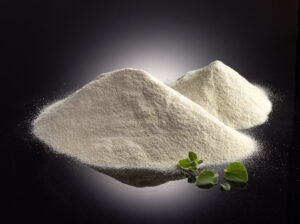 Dostofarm’s Dosto Ruminant bi-active is a coordinated combination of rumen-available and rumen-protected oregano oil, available as a premix for use in mineral and compound feeds. Essential oregano oil has long been known for its appetite-stimulating effect, which increases roughage intake, it also stimulates rumination activity, increases milk yield and milk constituents by positively influencing the rumen flora and has significant positive effects on metabolic disorders, udder health and somatic cell counts. The new combination of rumen-available and rumen-protected oregano oil is also available as Dosto TMR bi-active as a supplementary feed. It is used directly into the TMR at 50g per animal per day.
Dostofarm’s Dosto Ruminant bi-active is a coordinated combination of rumen-available and rumen-protected oregano oil, available as a premix for use in mineral and compound feeds. Essential oregano oil has long been known for its appetite-stimulating effect, which increases roughage intake, it also stimulates rumination activity, increases milk yield and milk constituents by positively influencing the rumen flora and has significant positive effects on metabolic disorders, udder health and somatic cell counts. The new combination of rumen-available and rumen-protected oregano oil is also available as Dosto TMR bi-active as a supplementary feed. It is used directly into the TMR at 50g per animal per day.
Autonomous feeding robot
GEA DairyFeed F4500
(Hall 13, stand C26)
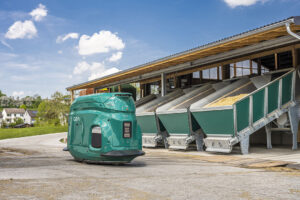 GEA is launching its DairyFeed F4500 feeding robot. The new feeder operates on sensor technology and can handle herds of up to 300 cows. It runs purely on electricity and can be recharged using renewable energies. The installation of the GEA DairyFeed F4500 also includes the automatic mapping of the farm with the help of laser scanners, including the definition of reference points and the driving route. Once the bunkers have been filled appropriately, the robot accurately weighs the optimum mix for each group of animals including additives, blends them, and feeds them at the desired times. The robot is linked to the GEA DairyNet herd management system and can be monitored and controlled from mobile devices in real time.
GEA is launching its DairyFeed F4500 feeding robot. The new feeder operates on sensor technology and can handle herds of up to 300 cows. It runs purely on electricity and can be recharged using renewable energies. The installation of the GEA DairyFeed F4500 also includes the automatic mapping of the farm with the help of laser scanners, including the definition of reference points and the driving route. Once the bunkers have been filled appropriately, the robot accurately weighs the optimum mix for each group of animals including additives, blends them, and feeds them at the desired times. The robot is linked to the GEA DairyNet herd management system and can be monitored and controlled from mobile devices in real time.
Self-propelled mixer wagon
Faresin Industries’ new Leader PF3 (Hall 27, stand F25)
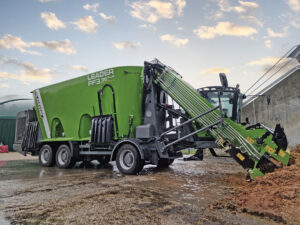 Italian Faresin Industries is introducing its new three-auger mixer wagon designed for large livestock farms from 1,000 head upwards. The wagon is available with 30m3 and 36m3 capacities and three steered axles. The front and rear drive axles are permanent four-wheel drive, and the servo-hydraulic steering on all axles are critical elements that reduce manoeuvring space even in small barns. Mixing and feeding can be carried out automatically as the new system interconnects all the devices of the machine and makes it possible, starting from the recipe, to program all its activities according to the raw materials that are gradually loaded.
Italian Faresin Industries is introducing its new three-auger mixer wagon designed for large livestock farms from 1,000 head upwards. The wagon is available with 30m3 and 36m3 capacities and three steered axles. The front and rear drive axles are permanent four-wheel drive, and the servo-hydraulic steering on all axles are critical elements that reduce manoeuvring space even in small barns. Mixing and feeding can be carried out automatically as the new system interconnects all the devices of the machine and makes it possible, starting from the recipe, to program all its activities according to the raw materials that are gradually loaded.
Self-propelled feeder models
Trioliet Triotrac M1 1700
(Hall 27, stand G32)
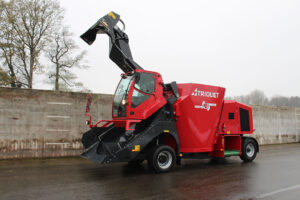 Trioliet will launch its Triotrac M compact self-propelled feeder models available in two sizes, 14m3 and 17m3. A small turning circle paired with four-wheel steering makes the Triotrac M especially easy to manoeuvre between buildings and within silage pits. It can extract silage at heights of up to 4.5 metres. The Triotrac M can also process round or square bales, loose by-products, mineral feed and even fodder beet or potatoes with ease. The spacious cab height can be adjusted. The joystick in the armrest is used to control the machine. All settings for loading, mixing and discharging the feed can be adjusted with the joystick. The diesel engine is located at the rear of the machine and easily accessible and very quiet. The Triotrac M can be fitted with a cross conveyor belt at the rear (AL) or discharge doors on both sides (ZK). A cross conveyor chain and an extension chain are also available to order for the AL machine.
Trioliet will launch its Triotrac M compact self-propelled feeder models available in two sizes, 14m3 and 17m3. A small turning circle paired with four-wheel steering makes the Triotrac M especially easy to manoeuvre between buildings and within silage pits. It can extract silage at heights of up to 4.5 metres. The Triotrac M can also process round or square bales, loose by-products, mineral feed and even fodder beet or potatoes with ease. The spacious cab height can be adjusted. The joystick in the armrest is used to control the machine. All settings for loading, mixing and discharging the feed can be adjusted with the joystick. The diesel engine is located at the rear of the machine and easily accessible and very quiet. The Triotrac M can be fitted with a cross conveyor belt at the rear (AL) or discharge doors on both sides (ZK). A cross conveyor chain and an extension chain are also available to order for the AL machine.
Updated loader
Schaffer
(Hall 26, stand G08)
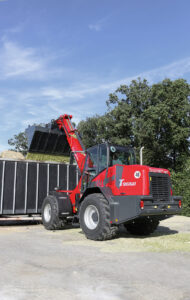 Schaffer is launching the successor to its 2028 loader as well as further options for its 6680 T and 9660 T models. The telescopic wheel loader 6680 T is now available with a 40km/h transmission and the 9660 T boasts a new and more powerful Deutz engine. The yard loader 2028-2 has a new electronic transmission, Schaffer Power Transmission (SPT), that makes the machine even more agile and boosts its thrust by 45%. The optional cruise control maintains the selected forward speed automatically, irrespective of the current engine speed.
Schaffer is launching the successor to its 2028 loader as well as further options for its 6680 T and 9660 T models. The telescopic wheel loader 6680 T is now available with a 40km/h transmission and the 9660 T boasts a new and more powerful Deutz engine. The yard loader 2028-2 has a new electronic transmission, Schaffer Power Transmission (SPT), that makes the machine even more agile and boosts its thrust by 45%. The optional cruise control maintains the selected forward speed automatically, irrespective of the current engine speed.
The 6680 T is a six ton machine that can lift the load to a height of 4.95m and travels at up to 40km/h. The thrust has been boosted by 13%, while the overall machine efficiency has increased by 8% for further reductions in fuel consumption and emissions. The high-speed version features the electronic SPT ground drive and the ecoMode as standard specification. The new flagship in the Schaffer programme is the 9660 T-2. This 13t heavy-weight is now powered by a Deutz TCD 5.2 engine of either 130kW (177hp) or 150kW (204hp). The 9660 T-2 is the world’s heaviest and most powerful telescopic wheel loader. Courtesy of its huge thrust and lift capacity of up to 5.3 tonnes and a lift height of 6.10m.
Around 1,700 exhibitors are set to bring their latest innovations and technology for the livestock sector to EuroTier in Hanover from 15 to 18 November 2022. Held every two years, EuroTier attracts over 150,000 visitors from around the world to see the latest innovations dedicated for livestock husbandry and welfare.


